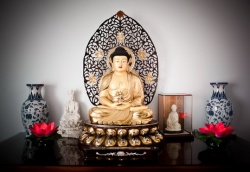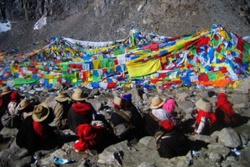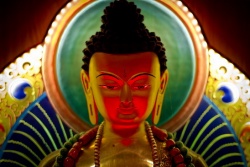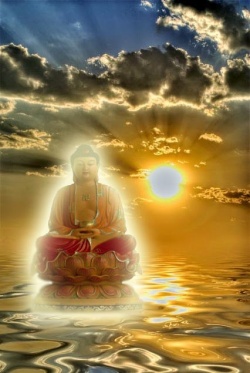Nalanda University and the suppressed Buddhist Identity
by Senaka Weeraratna, Lanka Daily News, August 1, 2013
Colombo, Sri Lanka -- This entire project led by Dr. Amrtya Sen must be made the basis of a wide ranging discussion in the Buddhist world in respect to the direction, organization, content of teaching, and aims and objectives that this proposed Nalanda International University is being encouraged to adopt.
The historic Nalanda University was essentially a Mahayana Buddhist Center of learning and had as its Directors (or Rectors) some of the learned Buddhist Monks then existing.
One reputed writer Alexander Berzin (2002) says:
"In the Indian Mahayana Buddhist monasteries, such as Nalanda, monks studied four systems of Buddhist tenets. Two – Vaibhashika and Sautrantika – were subdivisions of the Sarvastivada school within Hinayana. The other two – Chittamatra and Madhyamaka – were subdivisions within Mahayana."
Wikipedia says:
"Nalanda was one of the world's first residential universities, i.e., it had dormitories for students. It is also one of the most famous universities. In its heyday, it accommodated over 10,000 students and 2,000 teachers. Chinese pilgrims estimated the students between 3,000 and 5,000.
The university was considered an architectural masterpiece, and was marked by a lofty wall and one gate. Nalanda had eight separate compounds and ten temples, along with many other meditation halls and classrooms.
On the grounds were lakes and parks. The library was located in a nine storied building where meticulous copies of texts were produced.
The subjects taught at Nalanda University covered every field of learning, and it attracted pupils and scholars from Korea, Japan, China, Tibet, Indonesia, Persia and Turkey. During the period of Harsha, the monastery is reported to have owned 200 villages given as grants."
https://en.wikipedia.org/wiki/Nalanda
Among some of its famous Abbots were: Shakyashribhadra.
The scholar Dharmakirti (ca. 7th century), one of the Buddhist founders of Indian philosophical logic, as well as and one of the primary theorists of Buddhist atomism, taught at Nalanda. Both Mahayana Buddhism and Nalanda University influenced each other.
The old Nalanda University was a not secular University by any means.
It had a Buddhist Character for over 700 years right from its beginnings in the Fifth Century A.D ( reign of Sakraditya ) until its unfortunate end in 1193, when the Nalanda University was sacked by Bakhtiyar Khilji, a Turk.
The Persian historian Minhaj-i-Siraj, in his chronicle the Tabaqat-I-Nasiri, has reported that thousands of monks were burned alive and thousands beheaded as Khilji tried his best to uproot Buddhism.
The burning of the library had continued for several months and "smoke from the burning manuscripts hung for days like a dark pall over the low hills."
The last throne-holder of Nalanda, Shakyashribhadra, fled to Tibet in 1204 at the invitation of the Tibetan translator Tropu Lotsawa (Khro-phu Lo-tsa-ba Byams-pa dpal).
In Tibet, he started an ordination lineage of the Mulasarvastivadin lineage to complement the two existing ones.
New proposed Nalanda International University
Nalanda University (also known as University of Nalanda) is the name of a proposed university in Rajgir, near Nalanda, Bihar, India.
The first academic session is set to start from 2014.The university is a plan for reviving and re-establishing Nalanda University.
The University of Nalanda is proposed to be established under the aegis of the East Asia Summit (EAS), as a regional initiative. The NMG also has representatives from Singapore, China, Japan and Thailand.
The Governing Board of Nalanda University consists of:
Amartya Sen - Professor at Harvard University.
Sugata Bose - Professor at Harvard University.
Wang Bangwei - Professor at Peking University.
Wang Gungwu - Professor at National University of Singapore.
Susumu Nakanishi - Professor at Kyoto City University of Arts.
Meghnad Desai - Emeritus Professor at London School of Economics.
Prapod Assavavirulhakarn - Professor at Chulalongkorn University.
George Yeo - Former Minister for Foreign Affairs of Singapore.
Tansen Sen - Associate Professor at Baruch College, CUNY.
Nand Kishore Singh - Member of Parliament - Rajya Sabha, India.
Chandan Hareram Kharwar - Pune university - India.
Comment
There is a huge difference in the scope and direction of the old and the proposed new Nalanda University.
Whereas eminent Buddhist scholar monks were the rectors of the famed old Nalanda University, in the proposed new set up there does not appear to be a single Buddhist monk on the Board of Governors.
The overwhelming majority of the Governors have ' secular' credentials including the leader of the Project, Amartya Sen - Professor at Harvard University.
Lay Buddhists are very much in the minority on the Board of Governors. There is no Sri Lankan presence on the Board despite this country's claim to have the oldest continuing Buddhist civilization in the world.
Most of Sen's public pronouncements on this subject lately have been on the wisdom and validity of ' Secularism' over and above the innate value and depth of the Indian spiritual Heritage which includes Buddhism.
It shows that it pays to be a secularist even for an Indian in Western Professional and academic circles.
But it is tantamount to blasphemy to downsize your own i.e. Indian wisdom and religious heritage, merely to display that one is on the right side of intellectual fashion in the West.
Amartya Sen illustrates this proposition vividly.
It is unlikely that some one from the Middle East or Muslim country would try to create a secular place of learning on top of a destroyed site of a reputed Islamic Tertiary Institution.
That is unthinkable.
In Buddhist and Hindu societies 'secularists' have come to the fore and are now engaged in a state of play going virtually unchallenged downsizing the influence and scope of the traditional religions which built the unique civilizations that we find in India and Sri Lanka and still attract the attention and wonder of the world.



